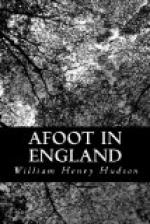for that small harvest. Yet I could understand
and even appreciate their work, although it is probable
that the glow I experienced was in part reflected.
Perhaps my mental attitude, when standing in that
sheltered place, and when getting on to the windy wall
I looked down on the workers and their work, was merely
benevolent. I had pleasure in their pleasure,
and a vague desire for a better understanding, a closer
alliance and harmony. It was the desire that
we might all see nature—the globe with
all it contains—as one harmonious whole,
not as groups of things, or phenomena, unrelated,
cast there by chance or by careless or contemptuous
gods. This dust of past ages, dug out of a wheat-field,
with its fragments of men’s work—its
pottery and tiles and stones—this is a part,
too, even as the small birds, with their little motives
and passions, so like man’s, are a part.
I thought with self shame of my own sins in this
connection; then, considering the lesser faults on
the other side, I wished that Mr. St. John Hope would
experience a like softening mood and regret that he
had abused the ivy. It grieves me to hear it
called a “noxious weed.” That perished
people, whose remains in this land so deeply interest
him, were the mightiest “builders of ruins”
the world has known; but who except the archaeologist
would wish to see these piled stones in their naked
harshness, striking the mind with dismay at the thought
of Time and its perpetual desolations! I like
better the old Spanish poet who says, “What
of Rome; its world-conquering power, and majesty and
glory—what has it come to?” The ivy
on the wall, the yellow wallflower, tell it.
A “deadly parasite” quotha! Is
it not well that this plant, this evergreen tapestry
of innumerable leaves, should cover and partly hide
and partly reveal the “strange defeatures”
the centuries have set on man’s greatest works?
I would have no ruin nor no old and noble building
without it; for not only does it beautify decay, but
from long association it has come to be in the mind
a very part of such scenes and so interwoven with the
human tragedy, that, like the churchyard yew, it seems
the most human of green things.
Here in September great masses of the plant are already
showing a greenish cream-colour of the opening blossoms,
which will be at their perfection in October.
Then, when the sun shines, there will be no lingering
red admiral, nor blue fly or fly of any colour, nor
yellow wasp, nor any honey-eating or late honey-gathering
insect that will not be here to feed on the ivy’s
sweetness. And behind the blossoming curtain,
alive with the minute, multitudinous, swift-moving,
glittering forms, some nobler form will be hidden
in a hole or fissure in the wall. Here on many
a night I have listened to the sibilant screech of
the white owl and the brown owl’s clear, long-drawn,
quavering lamentation:
“Good Ivy, what
byrdys hast thou?”
“Non but the Howlet, that How!
How!”




